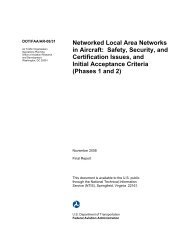Published Report (DOT/FAA/CT-94-36)
Published Report (DOT/FAA/CT-94-36)
Published Report (DOT/FAA/CT-94-36)
You also want an ePaper? Increase the reach of your titles
YUMPU automatically turns print PDFs into web optimized ePapers that Google loves.
e estimated as the ratio of the number of TCV's to the total<br />
number of at-risk blunders. However, when an experiment is<br />
performed from a known Bernoulli process, such as flipping a coin<br />
or rolling a die, it is known that the observed estimate of the<br />
probability will differ from the theoretic or underlying<br />
probability and that different experiments will produce different<br />
estimates of the same underlying probability. Thus the ratio of<br />
TCVIs to at-risk blunders should not be used directly as the<br />
estimate of the underlying probability.<br />
From the theory of Bernoulli processes, confidence intervals of<br />
the underlying probability may be determined from the observed<br />
data. A confidence interval gives a measure of the variation from<br />
the underlying probability that may be observed in experimental<br />
data. Confidence intervals always have a probability or<br />
confidence level associated with them. A confidence interval<br />
might be termed a 0.99 interval. This would mean that if 100<br />
different experiments were performed to estimate the underlying<br />
probability, then it would be expected that about 99 of the<br />
confidence intervals computed from the observed data would<br />
contain the underlying probability.<br />
Formulae exist for the computation of confidence intervals of<br />
Bernoulli probabilities. Since the probability of a TCV is very<br />
small, the appropriate formulae for the upper and lower limits of<br />
a 0.99 confidence interval are as follows:<br />
k<br />
zc(n,y)pY(l-p)n-y = 0.005<br />
y=o<br />
n<br />
C c( n, y)py (1 - p)"-' = 0.005<br />
y= k<br />
The value of the probability, p, must be found using numerical<br />
methods such as Newton's method or the bisection method.<br />
Since in a computation of risk conservatism is extremely<br />
important, the value associated with the upper limit of the<br />
confidence interval is the only one of interest. The upper limit<br />
of a 0.99 confidence interval represents a value which is almost<br />
certainly larger than the actual underlying probability. Thus<br />
use of the upper confidence interval bound will provide a<br />
conservative estimate of the actual probability.<br />
6.0 DETERMINATION OF ACCEPTABLE BLUNDER RATE<br />
With the determination of a target risk, a method of determining<br />
the window of alignment, and a method of estimating the<br />
probability of a TCV during an aligned blunder, the acceptable<br />
L-12

















